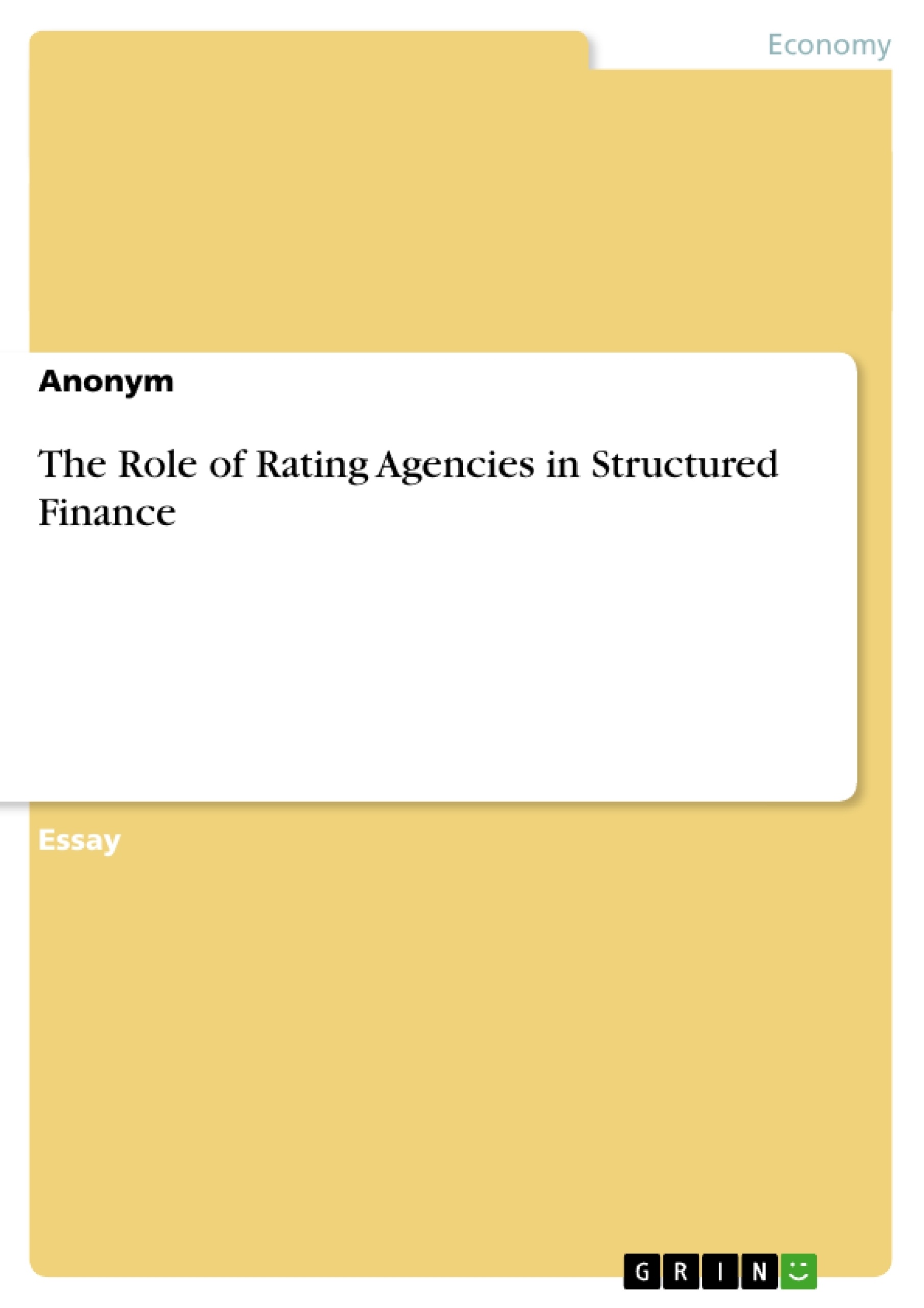“There are two superpowers in the world […] the United States and Moody’s Bond Rating Service” – Thomas L. Friedman, NY Times
The above statement by Thomas L. Friedman accentuates the importance of credit rating agencies (CRAs) in modern financial markets. As the past months have shown, Friedman’s statement has held especially true for the role of CRAs in the structured finance market, where CRAs are currently being made responsible for playing an integral role in the emergence of one of the biggest financial crises of mankind: the subprime crisis. The role and the importance of CRAs in the structured finance market is the central topic of the following paper. To fully understand the impact of this issue on the worldwide financial markets, it is interesting to shed some light onto the dimensions of the structured finance market. The market is of considerable size given that outstanding structured finance securities in the United States amounted to 7.3 trillion US dollars in 2005 (Nomura, 2005) and have now grown to 9 trillion US dollars, which is more than two thirds of the United States GDP of 13.1 trillion US dollars in 2007 (U.S. Bureau of Economic Analysis, BEA, 2007). More-over, these outstanding structured finance securities represent more than 30% of the total outstandings in the U.S. bond markets (Nomura, 2005). As these figure reveal, it is not surprising that complications in the core of the huge market of structured finance could potentially lead to a major destabilisation of the entire worldwide financial markets; a risk that was obviously underestimated for a long time and finally lead to the genesis of the sub-prime crisis.
The role of CRAs in the structured finance market has long been debated and the current financial turmoil has brought about concerns regarding such questions as to whether these credit ratings were based on wrong information and faulty or dated models, thereby questioning the significance of the system of CRAs. To enable a better insight into the functioning of CRAs and a justified testimony as to their performance, the following paper will dig deeply into the ambiguity of the rating process and the role of CRAs in structured finance.
Inhaltsverzeichnis (Table of Contents)
- Introduction
- Course of the Investigation
- Introduction to Credit Rating Agencies
- Mechanism of Securitization
- The Role of CRAs in Structured Finance
- Rating Process
- Interdependencies
- Importance of Structured Finance Ratings
- Particularities and Challenges of the Rating Process
- Introduction to the Major Problem Areas of CRA
- Particularities of the Rating Process
- Particularities of the Market of CRA
- Particularities of the Structured Finance Market
- Conclusion
Zielsetzung und Themenschwerpunkte (Objectives and Key Themes)
This paper analyzes the role of credit rating agencies (CRAs) in the structured finance market, specifically focusing on the impact of CRAs on the subprime crisis. The main objective is to understand the functioning of CRAs and their rating process within the context of structured finance. The paper explores the historical development of CRAs, their current market environment, and their relationship with investors, issuers, and regulators. Key themes include: * The role of CRAs in the securitization process. * The significance of structured finance ratings. * The interplay between CRAs, investors, issuers, and regulators. * Challenges and problems associated with the rating process. * The potential future development of CRAs in the structured finance market.Zusammenfassung der Kapitel (Chapter Summaries)
- Introduction: This introductory chapter provides an overview of the paper's topic, emphasizing the significance of CRAs in the structured finance market, particularly in light of the subprime crisis. The chapter highlights the size and growth of the structured finance market and its potential for destabilizing the global financial system.
- Introduction to Credit Rating Agencies: This chapter introduces the concept of CRAs, their functions, and their historical development. It traces the evolution of CRAs from mercantile credit agencies to modern institutions like Moody's Investors Services, Standard & Poor's, and Fitch Publishing Company.
- Mechanism of Securitization: This chapter focuses on the process of securitization, which involves converting assets into marketable securities. It explains how CRAs play a role in this process by providing ratings for the newly created securities.
- The Role of CRAs in Structured Finance: This chapter explores the specific role of CRAs in the structured finance market. It delves into the rating process, highlighting its iterative nature and the interdependencies between CRAs, issuers, investors, and regulators. The chapter also discusses the significance of structured finance ratings and the impact they have on investor decisions.
- Particularities and Challenges of the Rating Process: This chapter examines the challenges and problems associated with the rating process. It explores issues related to the nature of the rating process itself, the structured finance market, and the market of CRAs. The chapter also discusses potential biases and conflicts of interest that can arise in the rating process.
Schlüsselwörter (Keywords)
This paper focuses on the crucial role of credit rating agencies (CRAs) in the structured finance market. Key concepts include the securitization process, credit ratings, subprime crisis, investor behavior, and regulatory oversight.- Quote paper
- Anonym (Author), 2008, The Role of Rating Agencies in Structured Finance, Munich, GRIN Verlag, https://www.grin.com/document/129297



